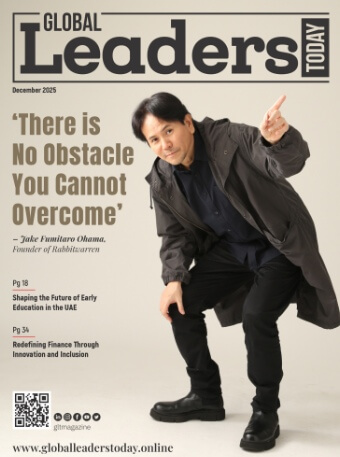- When Caring Becomes a Cage: How Over-Identification with Work Steals Your Self
- Redefining Finance Through Innovation and Inclusion
- ‘AI Prone To Errors, Use Alongside Other Tools’: Sundar Pichai
- ‘There is No Obstacle You Cannot Overcome’
- Pioneering Financial Innovation: Ali Alrawi and the Rise of Alfuras Group
Thought Leadership
Our features editor, Sherlyn, had the opportunity to sit down with Dr. Joanne Liu, a seasoned professional in the field of global health. Serving as the International President of Médecins Sans Frontières (MSF) from 2013 to 2019, Dr. Liu has amassed decades of experience working in conflict-ridden areas, dedicating her life to providing essential medical care to those in need. Specializing in pediatric medicine with a fellowship in pediatric emergency medicine, she holds the associate professor position at the Université de Montréal and has shared her expertise as an instructor at Fudan University in Shanghai. In 2013, Dr. Liu was honored with the Teasdale-Corti Humanitarian Award by the Royal College of Physicians and Surgeons of Canada for her outstanding contributions to global health and human rights.
Today, we have the privilege of delving into Dr. Liu’s remarkable journey, gaining insights into her leadership style, her experiences in crisis zones, and her vision for the future of global health.
1. Your work with Médecins Sans Frontières (MSF) has undoubtedly provided you with unique leadership experiences. In that context, how do you define effective leadership?
Effective leadership at MSF, given our mission, revolves around delivering essential care and access to healthcare during times of crisis to the most vulnerable and neglected populations. It requires the ability to adapt to changing circumstances, often in volatile environments swiftly.
2. Leading diverse teams in high-pressure and crisis situations, especially in conflict zones, is daunting. Please share some insights into your approach to this challenge.
It’s not about specific strategies but rather about adopting a humble approach. Conflict zones are inherently unpredictable, and in such environments, one must have the humility to listen to affected communities. At times, we must bet on imperfect solutions while maintaining the relentless energy to push for more. Complacency has no place in these chaotic contexts.
3. Empathy is a crucial aspect of leadership, especially in demanding environments. How does empathy shape your leadership style?
An empathetic mindset guards against a “white savior” attitude, bringing humanity and vulnerability to leadership. It reminds us that we are all human and encourages a more compassionate approach.
4. Your mantra of “patient first” is admirable. How do you prioritize patient-centered care while managing the complex logistics of medical interventions?
Patients are at the heart of decision-making, and our interventions stem from their needs.This approach, while seemingly simple, is the cornerstone of our mission. It reminds us that our ultimate goal is to provide essential medical care and support to those who need it most, and that goal is the compass by which we navigate the intricacies of delivering healthcare in crisis situations
5. Decision-making in fast-paced and rapidly changing situations is challenging. What’s your approach to maintaining clarity during such moments?
The clarity we seek is grounded in our mission of delivering critical medical aid to those in dire need, wherever they may be. In the midst of unpredictable and often chaotic environments, it’s about having the mental flexibility to adapt continuously. This adaptability ensures that our actions remain aligned with our overarching goal of providing medical care to those who need it most, even when circumstances are constantly shifting.
6. In your inspiring speech on imperfection, you mentioned preserving humanity. How does this principle influence your leadership philosophy?
Embracing our imperfections and vulnerabilities is essential to our approach to leadership and to serving others. It’s a principle that reminds us that, at our core, we are all human beings, and it’s our shared humanity that connects us on a deeply personal level. This connection is a driving force behind our actions and our commitment to making a positive impact in the world.
7. Are there any significant leadership lessons that stand out from your interactions with global leaders and organizations?
One critical lesson I’ve learned from my interactions with global leaders and organizations is that deals and negotiations happen between individuals, not just institutions. Building meaningful relationships with people, whether they are within the organization or external partners, is what truly facilitates smooth negotiations and successful collaborations. This emphasis on personal connections and human relationships has been a cornerstone of my leadership philosophy and continues to be a guiding principle in my approach to working with diverse teams and partners.
8. Looking ahead, how do you envision the future of organizations like MSF, given evolving global health challenges and changing geopolitical dynamics?
Although I am no longer at the helm of the organization, I anticipate significant challenges ahead. MSF will need to navigate a decolonized way of working, adapt to shifting global power dynamics, and reach the most remote populations amidst the compounding effects of climate change.
Written by contributing writer Judith Germain As the summer months draw to a close and the last quarter of 2023 is upon us, returning to work after a relaxed summer holiday can be just what someone...
Written by contributing writer Micah Solomon, Customer Service Consultant, Trainer, and Bestselling Author When my ConsultantPhone rings (it’s like the Batphone but notably less exciting), and...
The string theory is a fascinating concept in physics that aims to explain the fundamental nature of matter and energy in the universe. It suggests that all particles in the universe are composed of tiny,...
Cityscape Global is renowned as the largest real estate exhibition globally. It welcomed 350 exhibitors, over 10,000 international investors, an impressive lineup of more than 300 speakers, and an...
Written By Contributing Writers Jennifer L. Martin, ESQ., Valeria Oman, ESQ., and Melissa Bauman Ward, ESQ. There’s been a lot of buzz about bias lately, most of it negative. Wehe supposed to...
It goes without saying that the pandemic had a tremendous impact on the travel industry, with group travel hit harder than almost any other segment. Fortunately, the sector is recovering from this...
Written by contributing writer Rameez Kaleem, Founder & Managing Director, 3R Strategy With the cost of living crisis having a huge impact on the lives of many across the country, there has...
Written by Dr. Glenn Williams, Founder, LCP Global It’s 2023, and the hospitality and service industries are rebuilding. The COVID-19 global pandemic devastated sectors relying on a...
Written By Contributing Writers Vishal Gupta, Professor, IIM Ahmedabad And Shishir Arya, Founder, MyHeal Consulting The age of today is characterised by turbulent times. Recently, New Zealand Prime...

















